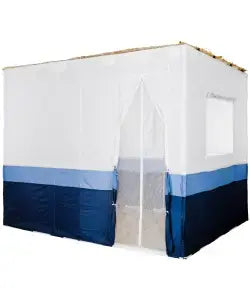Sukkot 2026: What You Need to Know This Year

Planning for Sukkot 2026 doesn't have to feel overwhelming. This guide helps you track important dates, understand customs, and get ready for a meaningful celebration of this sacred Jewish holiday.
When is Sukkot 2026?
Sukkot 2026 begins at sundown on Sunday, October 12, and ends at sundown on Sunday, October 19 in Israel (October 20 in the Diaspora). These dates follow the Jewish lunar calendar, where Sukkot always starts on the 15th of Tishri.
First Day of Sukkot: October 13, 2026
This is a full yom tov (holiday), with restrictions on work similar to Shabbat. Sukkot begins the evening before, on Sunday, October 12, with a festive meal in the sukkah.
How Long Does Sukkot Last?
-
In Israel: 7 days (ends October 19)
-
Outside Israel: 8 days (ends October 20)
The celebration continues with two additional days:
-
Shemini Atzeret: October 20
-
Simchat Torah: October 21
Sukkot 2026 Calendar Snapshot
-
Oct 12 (Sun eve): Sukkot begins
-
Oct 13 (Mon): First day (yom tov)
-
Oct 14–18 (Tues–Sat): Chol Hamoed (intermediate days)
-
Oct 19 (Sun): Final day in Israel
-
Oct 20 (Mon): Final day outside Israel + Shemini Atzeret
-
Oct 21 (Tues): Simchat Torah
This compressed timeline means you have limited time between Yom Kippur (October 1-2, 2026) and Sukkot to complete your preparations.

How is Sukkot Celebrated?
The question of how Sukkot is celebrated centers around dwelling in temporary outdoor structures called sukkahs and performing daily rituals with the Four Species. But the holiday's meaning extends far beyond these specific practices, encompassing themes of gratitude, divine protection, and the temporary nature of all earthly dwellings.
How is Sukkot Celebrated Around the World?
Sukkot celebrations vary dramatically across different Jewish communities, reflecting local climates, customs, and available materials. In Israel, where the weather is typically warm and dry during Sukkot, families often sleep in their sukkahs and spend extensive time outdoors. The holiday takes on a distinctly Mediterranean character with fresh fruits, outdoor cooking, and evening gatherings under the stars.
European communities developed different approaches, adapting to cooler climates and urban settings. Ashkenazi traditions often emphasize elaborate decorations and specific foods that reflect the harvest season. In places like New York or London, sukkahs might be built on apartment balconies or in small courtyards, requiring creative solutions for urban living.
Sephardic and Mizrahi communities bring their own rich traditions, often incorporating local architectural styles and regional foods into their Sukkot celebrations.
What Happens During Sukkot?
What happens during Sukkot goes far beyond simply eating meals in a temporary hut. Each day begins with morning prayers that include the ritual of the Four Species; holding together a palm branch (lulav), citron (etrog), myrtle branches (hadassim), and willow branches (aravot) while reciting specific blessings and waving them in six directions.
Meals become central events, with families gathering in their sukkahs for breakfast, lunch, and dinner when weather permits. The sukkah becomes a space for conversation, storytelling, and hospitality, with many families inviting guests to share meals and experience the unique atmosphere of outdoor dining.
Evening activities often include singing, studying religious texts, and the tradition of ushpizin; symbolically inviting biblical figures like Abraham, Isaac, and Jacob to join the celebration.
Jewish Festival Sukkot Traditions
The Jewish festival Sukkot encompasses traditions that connect contemporary celebrations to thousands of years of history. The practice of dwelling in temporary structures commemorates the Israelites' 40 years in the desert, but it also serves as an annual reminder of life's impermanence and our dependence on divine protection.
Traditional decorations include hanging fruits and vegetables from the sukkah walls and ceiling, creating a harvest festival atmosphere that celebrates the bounty of the earth. Paper chains, artwork created by children, and family photos often personalize each sukkah, making it a unique expression of family identity and creativity.
The custom of sukkah hopping, visiting different families' sukkahs throughout the holiday, strengthens community bonds and allows people to admire each other's creativity and craftsmanship

Simchat Torah, Chol Hamoed, and Shemini Atzeret in 2026
Understanding the holidays that surround and follow Sukkot helps you plan for what becomes an extended period of celebration and observance. These related observances each have their own character and requirements, creating a rich tapestry of Jewish autumn celebration.
Simchat Torah 2026
Simchat Torah 2026 falls on Tuesday, October 21-22, depending on your location and tradition. This joyful holiday celebrates the completion of the annual Torah reading cycle and the immediate beginning of a new cycle. The celebration involves dancing with Torah scrolls, special prayers, and often elaborate community festivities that can extend late into the evening.
In many communities, simchat torah becomes one of the most exuberant celebrations of the Jewish year, with singing, dancing, and festivities that welcome everyone regardless of their usual level of observance.
Shemini Atzeret 2026
Shemini Atzeret 2026 begins on Monday, October 20, immediately following Sukkot. This "eighth day of assembly" is technically a separate holiday, but it feels like an extension of Sukkot. The name means "eighth day of solemn assembly," and it includes special prayers for rain, crucial in Israel's Mediterranean climate.
During Shemini Atzeret, you no longer eat in the sukkah (in most traditions), marking the transition from the outdoor, temporary dwelling focus of Sukkot to a more inward, spiritual conclusion of the holiday season.
Chol Hamoed 2026
Chol hamoed 2026 refers to the intermediate days of Sukkot; October 14-18, when work restrictions are relaxed but the holiday atmosphere continues. These days offer opportunities for family outings, sukkah visits, and special activities that wouldn't be appropriate on the full holiday days.
Many families use chol hamoed for sukkah tours, visiting friends and relatives to see their temporary dwellings and share meals. Schools in Jewish communities often organize special programs, and some families plan trips or outings that incorporate the holiday's themes.
Preparing for Sukkot 2026
Successful Sukkot preparation requires balancing the spiritual significance of the holiday with the practical realities of construction, decoration, and meal planning. The compressed timeline between Yom Kippur and Sukkot means planning becomes essential for a meaningful celebration.
Building a Sukkah
Building a sukkah for 2026 should begin with planning during the summer months, especially if you're constructing from scratch. The basic requirements remain constant: at least two and a half walls, a minimum height of 40 inches, and a roof covering (schach) made from natural materials that provide more shade than sunlight while still allowing you to see stars.
Consider your local climate when planning. October weather can be unpredictable in many locations, so factor in potential rain, wind, or temperature variations. Material selection affects both cost and durability. Lumber creates the most permanent-feeling structure but requires more investment and storage space.
Acquiring the Four Species
The Four Species; lulav, etrog, hadassim, and aravot, require advance ordering in most locations outside major Jewish population centers. Quality varies significantly, and prices can range from modest to quite expensive, especially for premium etrogim.
Many synagogues organize group orders to reduce costs and ensure availability. The etrog, in particular, should be unblemished and have its pitom (small protrusion) intact if possible.
Planning Meals
Meal planning for Sukkot requires considering the logistics of outdoor dining, weather contingencies, and the extended nature of the celebration. Foods that transport well from the kitchen to the sukkah, maintain their temperature, and can be eaten comfortably in an outdoor setting work best.
Traditional Sukkot foods often reflect the harvest theme, stuffed vegetables, dishes featuring seasonal produce, and sweets made with honey or dates.
Planning Decorations
Decoration planning should balance traditional elements with personal creativity and practical considerations. Traditional decorations include hanging fruits and vegetables, but these need to be secured properly and replaced if they spoil during the week-long celebration.
Paper decorations, fabric hangings, and string lights create ambiance while being relatively weather-resistant. Children's artwork and family photos personalize the space and create conversation starters for guests.
Community Events
Many Jewish communities organize special Sukkot events, communal sukkah building, group tours, children's programs, and educational activities. Participating in these events can enhance your celebration while providing opportunities to learn from more experienced celebrants.
Check with local synagogues, Jewish community centers, and schools for scheduled activities.

Sukkot Rules, Restrictions, and Special Days
Understanding the framework of Sukkot observance helps you navigate the holiday's requirements while focusing on its spiritual significance. The rules serve to create meaningful experiences rather than arbitrary restrictions.
The Significance of Sukkot 2026
Sukkot 2026 carries particular significance as communities worldwide continue recovering from recent global challenges that highlighted the fragility of our seemingly permanent structures and systems. The holiday's themes of temporary dwelling, divine protection, and gratitude resonate strongly in times when many people have experienced disruption to their normal routines.
The agricultural roots of Sukkot connect to growing awareness of environmental issues and food security. Celebrating the harvest while dwelling in temporary structures made from natural materials creates opportunities for reflection on our relationship with the natural world.
Sukkot Work Restrictions You Should Know
Sukkot work restrictions apply differently to the various days of the holiday period. The first day (and second day outside Israel) carries full holiday restrictions similar to Shabbat, no driving, working, handling money, or cooking from scratch. Food preparation that enhances the holiday celebration is generally permitted, but specific rules vary between communities.
The intermediate days (Chol Hamoed) allow more flexibility. Many people work, run errands, and handle necessary business while maintaining the holiday's festive character.
Weather-related exceptions are built into the observance. You're not required to eat in your sukkah during rain, strong winds, or extreme temperatures.
Understanding the Jewish Calendar
The Jewish calendar system that determines when Sukkot is in 2026 reflects thousands of years of astronomical observation and mathematical calculation. The lunisolar calendar follows lunar months but adjusts to stay aligned with solar seasons, preventing holidays from drifting through the year.
Sukkot always falls on the 15th day of Tishrei, the seventh month of the Jewish year. The full moon timing isn't coincidental; many Jewish holidays occur on or near the 15th of the month, when the moon is full and provides natural lighting for evening celebrations.
As you plan for Sukkot 2026, remember that the goal isn't perfection but participation. The ancient Israelites built their temporary dwellings with whatever materials they had available, and your sukkah doesn't need to be more sophisticated than theirs.
Ready to Make Sukkot 2026 Your Most Meaningful Celebration Yet?
Sukkah Market offers everything you need, from complete sukkah kits to EZ Lock sukkah systems, panel sukkahs, and pop-up sukkahs for easy setup. Even if you're interested in a custom sukkah, need help decorating a sukkah, want quality bamboo schach mats, or need detailed sukkah building instructions, we're here to help.
Looking for a sukkah for sale near me, or want to contact Sukkah Market for personalized guidance? We're committed to helping you create a sukkot 2026 celebration that brings the ancient traditions to life in your own backyard.
Sukkot 2026 FAQs: Key Dates, Traditions, and Planning Tips
When Does Sukkot 2026 Begin and End?
Sukkot 2026 begins at sundown on Sunday, October 12, and ends on Sunday, October 19 in Israel or Monday, October 20 in the Diaspora. These dates follow the Jewish calendar and mark a sacred time of outdoor dwelling, gratitude, and celebration.
What is the Difference Between Sukkot and Shemini Atzeret 2026?
Sukkot concludes after seven or eight days, while Shemini Atzeret 2026 (October 20) is a separate holiday that includes prayers for rain and a spiritual transition. In most traditions, meals move indoors, and the focus shifts from the physical sukkah to internal reflection.
How Long Does Sukkot Last in the Diaspora?
Sukkot lasts 8 days outside of Israel, ending with Shemini Atzeret. Simchat Torah follows immediately, extending the festive atmosphere. The additional days reflect Diaspora traditions that preserve ancient calendar accuracy and deepen communal observance.
What Are the Sukkot 2026 Work Restrictions?
On full yom tov days—October 13 and October 20—work is prohibited, similar to Shabbat. Cooking for that day is allowed. During Chol Hamoed (Oct 14–18), many types of work are permitted if they don't detract from the holiday experience.
When Should I Order My Sukkah Kit for Sukkot 2026?
Because Sukkot begins shortly after Yom Kippur, it’s best to order your sukkah kit, bamboo schach, and Four Species by early September 2026. Early preparation ensures on-time delivery and gives you time to decorate and personalize your sukkah.







